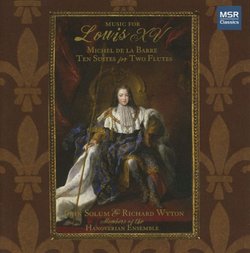| All Artists: John Solum (flute); Richard Wyton (flute) Title: Music for Louis XV: Michel de la Barre 10 Suites for 2 Flutes Members Wishing: 1 Total Copies: 0 Label: MSR Classics Original Release Date: 1/1/2007 Re-Release Date: 1/30/2007 Genre: Classical Styles: Chamber Music, Historical Periods, Baroque (c.1600-1750), Classical (c.1770-1830) Number of Discs: 1 SwapaCD Credits: 1 UPC: 681585119129 |
Search - John Solum (flute); Richard Wyton (flute) :: Music for Louis XV: Michel de la Barre 10 Suites for 2 Flutes
 | John Solum (flute); Richard Wyton (flute) Music for Louis XV: Michel de la Barre 10 Suites for 2 Flutes Genre: Classical
Louis XV was born in 1710 in Versailles. In 1715 at the age of five he succeeded to the throne of France upon the death of his great-grandfather, Louis XIV. He inherited a court notable for its brilliant accomplishments in... more » |
Larger Image |
CD Details
Synopsis
Product Description
Louis XV was born in 1710 in Versailles. In 1715 at the age of five he succeeded to the throne of France upon the death of his great-grandfather, Louis XIV. He inherited a court notable for its brilliant accomplishments in the arts and literature. A distinct musical style had evolved at Louis XIV s court, principally developed by such composers as Lully, Marais and Lalande. Charpentier, working outside of the court, also contributed to the style. Among the musicians and composers at Louis XIV s court who continued to work under Louis XV was the flutist, Michel de la Barre (c.1675-1745). About the time of La Barre s birth, the transverse flute underwent two important changes. Before then, the flute had a cylindrical bore and had no keys (levers) to close holes beyond the reach of the fingers. However, around 1670 flute-makers in France as well in the Netherlands added a key, thus enabling the flute for the first time to play every note of the chromatic scale. At the same time the interior bore was redesigned from a cylindrical shape to conical (tapering from the head to the foot of the flute), thus increasing tonal power and improving intonation. This flute we now call the Baroque flute. Much of the music which La Barre composed was for the Baroque transverse flute. Moreover, he is given credit for having published the first solo flute music for this newly-designed flute. In 1702 Christophe Ballard printed La Barre s Opus 4, Pieces pour la flute traversiere avec la basse-continue, containing five suites. These are the first solo works published anywhere for the new one-keyed conical flute. La Barre was fully aware of his achievement; in the introduction to the Opus 4 publication, he states that these pieces are the first to appear for that kind of flute. La Barre may thus be regarded as a seminal figure of the modern flute repertoire.

 Track Listings (33) - Disc #1
Track Listings (33) - Disc #1